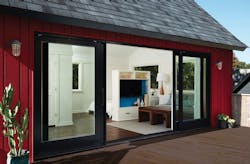Small Units, Big Potential
Senior editor Sue Bady wants to set something straight: Accessory dwelling units aren’t the same thing as tiny houses. As you’ll read in “Much Ado About ADUs,” such structures have existed in North American cities since early last century, when homeowners needed space for extended family to live. Sound familiar?
“I hesitate to say ‘perfect storm’ because it’s a cliché, but that’s what’s driving this,” Bady notes of renewed interest in the ADU. You know the reasons: home prices outpacing wages, land prices through the roof, a rising tide of Millennials who can’t swing a down payment, and a burgeoning elder population projected to continue expanding well past 2050 (Photo: Courtesy Second Suite).
There’s a strong case for supporting ADUs. Whether an above-garage apartment or a detached 900-square-foot cottage, today’s ADUs are a world away from the backyard shacks of 100 years ago. Builders such as Hammer & Hand, in Seattle and Portland, Ore., offer portfolios on their websites of backyard homes, each more appealing than the next, complete with information on cost, permitting, and jurisdictions.
While Portland and Seattle, as well as Austin, Texas, Minneapolis, and Vancouver, Canada, have taken steps to work out regulatory issues, more jurisdictions need to hop onboard. Bady points out that American cities in which the cost of housing is high and in which ADUs are feasible—Chicago, Los Angeles, and New York, for instance—don’t allow them yet, even though they’ve been shown to raise property values.
In reporting the story, Bady learned that Vancouver is a case study in doing it right: allowing ADUs on every single-family lot in the city. And, by getting the buy-in of the entire city, Vancouver managed to avoid repeatedly fighting the same battles, as would happen if this were rolled out neighborhood by neighborhood.
There’s another selling point to ADUs. “You’re using existing infrastructure, utilizing what’s already there, and taking up less of a footprint to do it,” Bady points out. As for what to do with the space after elderly parents or boomerang kids move on, there are flex or rental possibilities.
Pushback likely won’t go away, yet ADUs have potential as long-term housing for the underserved. Austin imposes rent-control regulations to enforce long-term occupancy by those of modest means. At a time when first responders, teachers, and other workers often can’t afford to live in the very communities they serve, ADUs are an idea that’s hard to argue with.

